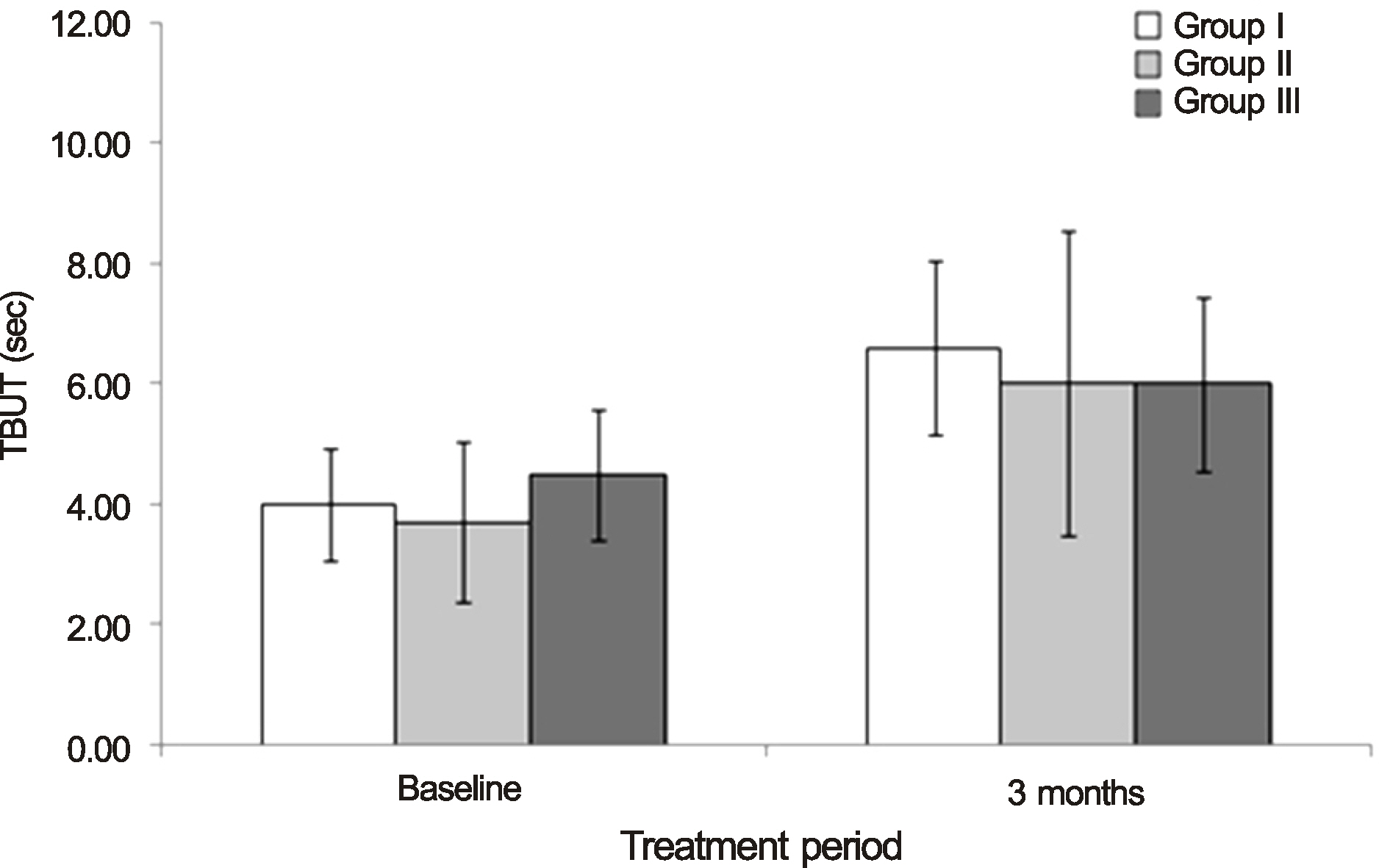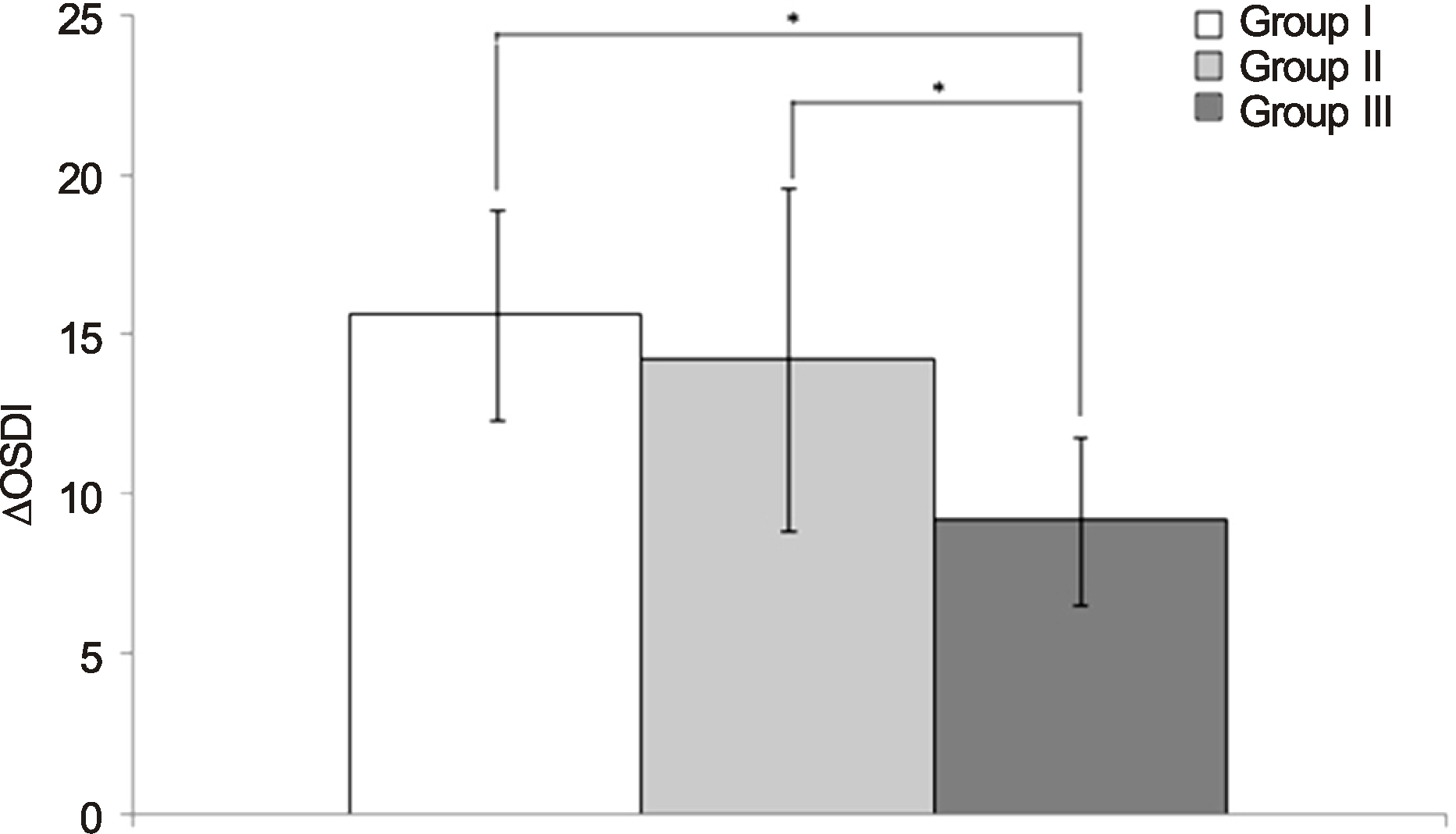J Korean Ophthalmol Soc.
2014 Sep;55(9):1307-1312. 10.3341/jkos.2014.55.9.1307.
The Effects of Lower Lid Laxity to the Response of Dry Eye Treatments
- Affiliations
-
- 1Department of Ophthalmology, Incheon St. Mary's Hospital, The Catholic University of Korea College of Medicine, Seoul, Korea. nyny5555@naver.com
- KMID: 2217113
- DOI: http://doi.org/10.3341/jkos.2014.55.9.1307
Abstract
- PURPOSE
To compare the response of dry eye treatment in patients divided by the degree of lower lid laxity.
METHODS
Thirty patients were classified into three groups - normal, moderate and severe, according to the degree of lower lid laxity. Tear break-up time (TBUT), Schirmer test (ST), ocular surface disease index (OSDI) scores and changes in OSDI score in each group were compared before and at 3 months after the treatment.
RESULTS
TBUT, ST and OSDI scores were not different among the three groups at baseline. TBUT improved to 6.60 +/- 1.43, 6.0 +/- 2.54 and 6.0 +/- 1.45 sec in normal, moderate and severe lower lid laxity group, respectively at 3 months after the treatment and no difference among the groups was found. ST scores did not increase after the treatment, while OSDI scores improved to 12.20 +/- 1.40, 16.10 +/- 4.63 and 20.80 +/- 4.52 in each group, respectively and they were significantly different (p = 0.029, 0.029, <0.001, respectively). The response to the dry eye treatment as assessed by changes in OSDI scores was poorer in patients in the severe lower lid laxity group (p = 0.019 vs. moderate laxity group, <0.01 vs. normal group).
CONCLUSIONS
As the degree of lower lid laxity increases, the response to dry eye treatment becomes poorer even when TBUT increases.
Keyword
MeSH Terms
Figure
Reference
-
References
1. The definition and classification of dry eye disease: report of the Definition and Classification Subcommittee of the International Dry Eye WorkShop (2007). Ocul Surf. 2007; 5:75–92.2. Shimazaki-Den S, Iseda H, Dogru M, Shimazaki J. Effects of diquafosol sodium eye drops on tear film stability in short BUT type of dry eye. Cornea. 2013; 32:1120–5.
Article3. Cho BJ, Lee JH, Shim OJ. The relation between clinical manifestations of dry eye patients and their BUTs. J Korean Ophthalmol Soc. 1992; 33:297–302.4. Nichols KK, Nichols JJ, Mitchell GL. The lack of association between signs and symptoms in patients with dry eye disease. Cornea. 2004; 23:762–70.
Article5. Rees TD, Jelks GW. Blepharoplasty and the dry eye syndrome: guidelines for surgery? Plast Reconstr Surg. 1981; 68:249–52.6. Mastrota KM. Impact of floppy eyelid syndrome in ocular surface and dry eye disease. Optom Vis Sci. 2008; 85:814–6.
Article7. Amano S. MGD Working Group: Definition and diagnostic criteria for meibomian gland dysfunction. J Eye (Atarashii Ganka). 2010; 27:627–31.8. Dana MR, Hamrah P. Role of immunity and inflammation in corneal and ocular surface disease associated with dry eye. Adv Exp Med Biol. 2002; 506:729–38.
Article9. Stern ME, Gao J, Siemasko KF, et al. The role of the lacrimal functional unit in the pathophysiology of dry eye. Exp Eye Res. 2004; 78:409–16.
Article10. Le Q, Ge L, Li M, et al. Comparison on the vision-related quality of life between outpatients and general population with dry eye syndrome. Acta Ophthalmol. 2014; 92:e124–32.
Article11. Li M, Gong L, Chapin WJ, Zhu M. Assessment of vision-related quality of life in dry eye patients. Invest Ophthalmol Vis Sci. 2012; 53:5722–7.
Article12. Gonnering RS, Sonneland PR. Meibomian gland dysfunction in floppy eyelid syndrome. Ophthal Plast Reconstr Surg. 1987; 3:99–103.
Article13. Bron AJ, Tiffany JM, Gouveia SM, et al. Functional aspects of the tear film lipid layer. Exp Eye Res. 2004; 78:347–60.
Article14. Liu DT, Di Pascuale MA, Sawai J, et al. Tear film dynamics in floppy eyelid syndrome. Invest Ophthalmol Vis Sci. 2005; 46:1188–94.
Article15. Toda I, Fujishima H, Tsubota K. Ocular fatigue is the major symptom of dry eye. Acta Ophthalmol (Copenh). 1993; 71:347–52.
Article16. Jeong HS, Lim JS, Oh DK, et al. Prevalence and risk factors of dry eye syndrome in the Incheon area. J Korean Ophthalmol Soc. 2011; 52:1135–41.
Article
- Full Text Links
- Actions
-
Cited
- CITED
-
- Close
- Share
- Similar articles
-
- Correction of Involutional Entropion by the Amount of Lower Eyelid Laxity
- Surgical Treatment of Sensile Entropion
- Lid Wiper Epitheliopathy in Patients with Dry Eye Refractory to Conventional Medical Treatment
- Long-term Results of Interrupted Buried Suture Method Using Non-absorbable Material for Involutional Lower Lid Entropion
- Recent treatment of dry eye





